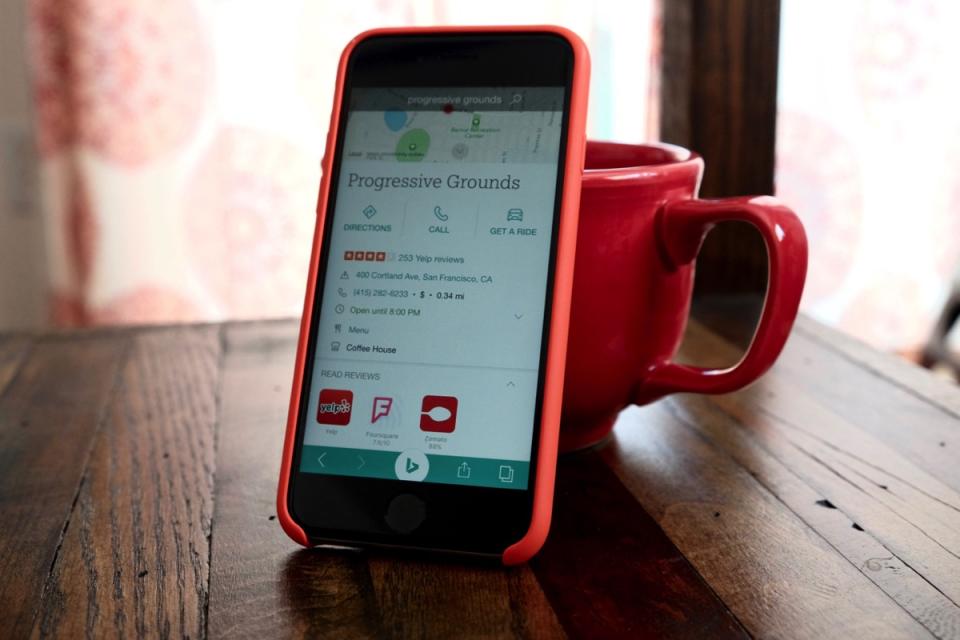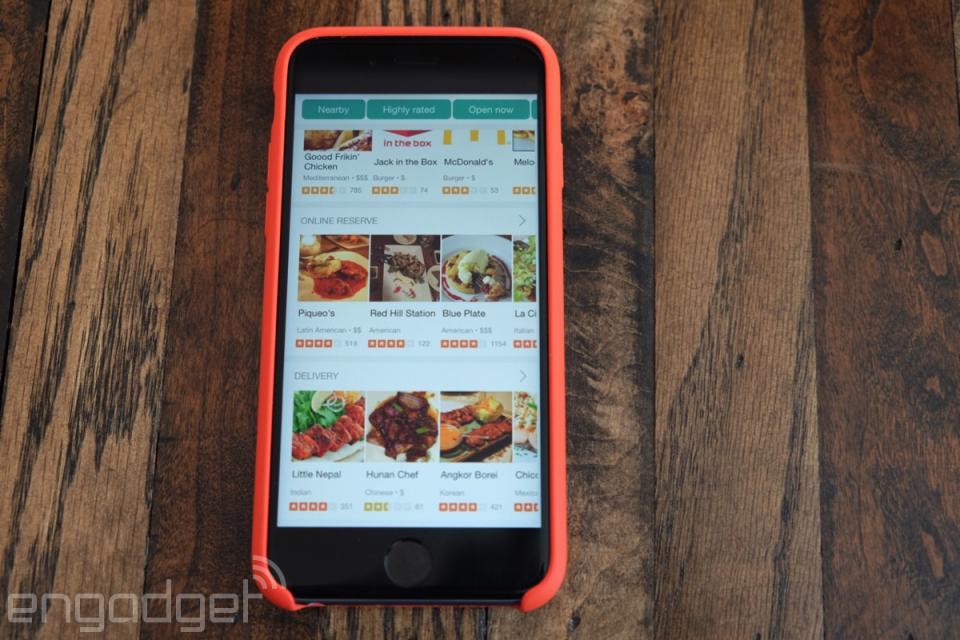Bing for iPhone makes it easy to jump from search straight to your apps

As Windows Phone continues to struggle, Microsoft has turned its focus towards making its trademark services like Office, Outlook and Bing available on Android and iOS. Today, the Bing app for the iPhone is getting a major update to better reflect how users want to search when on their phones, something that's been an increasing priority for Google as well.
Ryan Gavin, Microsoft's GM of search, says that when he thinks how about mobile search differs from the desktop, the traditional list of search results that can get you eventually to an answer to a query aren't useful. "I just want an answer," Gavin says, "and I want to take that answer into an action, typically with some sense of urgency." To that end, Bing for iPhone puts the data from Microsoft's Knowledge and Action Graph right up front, alongside deep links right into the apps on your phone that'll let you complete the desired action using the tools you're used to.
The knowledge and action graph isn't dissimilar to Google's own Knowledge Graph: It's a database that pulls up relevant info for a search term based on connections between the massive amount of data on the internet. Gavin says that Microsoft's graph connects 21 billion facts, 18 billion facts and 5 billion relationships, "all interconnected to understand the relationships between them."
That means that when you search for San Francisco, you don't just get a list of webpages, you get images, relevant info from Wikipedia, related news articles and facts like population, nearby airports, travel tips and more. This style search is particularly relevant on mobile so you can get info without having to click through to other websites, and it lets search engines answer natural-language questions (like "what is the population of New York City?") without you having to dig through a list of search results.
Bing is focused on getting you an answer to your question as quick as possible.
While Google and Bing's knowledge graphs give you similar info, the new Bing app for iPhone steps things up by integrating search results with the iOS app ecosystem. If I tell Bing to show me coffee shops nearby, I get the expected list of options based on my location -- but clicking through to a specific option pulls in a variety of data from the internet as well as a list of apps you can use to complete various tasks.

Tapping on a local Philz Coffee shop brought up its Yelp score, location, phone number, menu, hours and so forth, but there were also links right up top for directions, calling the shop, and "getting a ride." Tapping that last option prompted my phone to open Uber, an example of how Bing now links up with apps on your phone. Scrolling down would show more groups of apps I could use to find out more info about the shop; you can look at reviews on Yelp or Foursquare, "get there" by opening Google Maps, Uber or Lyft, or see the shop's page in Facebook.
Looking up a movie prompted me to open Fandango to buy tickets or Rotten Tomatos to see reviews. And if you don't have the specific app installed, Bing will just show you the mobile web page instead. It's similar to what Google does in Android and has started doing this year in iOS, but I honestly have seen very few app links when searching with Google. That's not the case with Bing, as app integration appears to be at the forefront of this redesign.
Integration with your apps was a top priority for Microsoft.
Even when you don't need to jump into other apps, the experience inside of Bing is tightly integrated with other web services. For example, searching for "Taylor Swift Bad Blood" brought up both the infamous video as well as the song's lyrics right below. The video plays right at the top of the screen from YouTube, and you can just turn your phone on its side to go full-screen. Searching for an album or a movie brought up different places where you could listen or watch -- movie searching in particular was smart, showing me that I could buy or rent on iTunes or head over to Amazon or Netflix to stream it directly.
The entry screen of the Bing app has been redesigned, as well. Instead of a static search box, there are now quick links to a variety of local info: you can quickly things near you that you can filter by categories like coffee, gas, lunch, bars, and so forth. That local tab also shows off nearby points of interest. From the homepage you can also jump to restaurants, movies, images, videos and maps, and scroll down from there to see the same news articles that are presented on the Bing.com homepage. And, of course, the trademark Bing image of the day is there as well for you to save and use as a wallpaper on your phone.
The big question for Microsoft is how to convince users to give the Bing app more of a shot. While there's no question that both the Bing and Google apps offering plenty of features, it's probably easier for a lot of iOS users just to search in Safari directly. And iOS 9 has done a good job of tying local results from the Maps app into searches, both in Safari and from the redesigned Spotlight search area. While those default tools are likely good enough for a lot of users, the new Bing app definitely feels like a more "mobile-native" search experience. Between voice integration, the quick access to local info without having to type and the integration with your app collection, Bing for iPhone is definitely worth a look if you want a deeper search experience.












